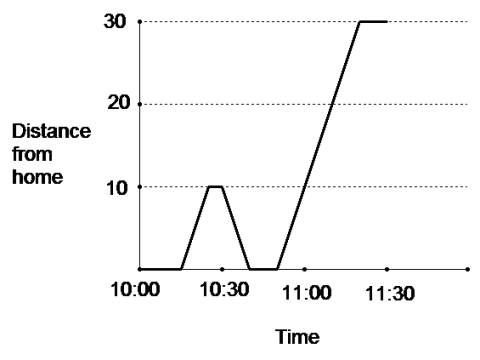Hints will display for most wrong answers; explanations for most right answers. You can attempt a question multiple times; it will only be scored correct if you get it right the first time. To see five new questions, reload the page.
I used the official objectives and sample test to construct these questions, but cannot promise that they accurately reflect what’s on the real test. Some of the sample questions were more convoluted than I could bear to write. See terms of use. See the MTEL Practice Test main page to view questions on a particular topic or to download paper practice tests.
MTEL General Curriculum Mathematics Practice
Question 1 |
Here are some statements:
I) 5 is an integer II)\( -5 \) is an integer III) \(0\) is an integer
Which of the statements are true?
I only | |
I and II only | |
I and III only | |
I, II, and IIIHint: The integers are ...-3, -2, -1, 0, 1, 2, 3, .... |
Question 2 |
Use the graph below to answer the question that follows:

The graph above best matches which of the following scenarios:
George left home at 10:00 and drove to work on a crooked path. He was stopped in traffic at 10:30 and 10:45. He drove 30 miles total.Hint: Just because he ended up 30 miles from home doesn't mean he drove 30 miles total. | |
George drove to work. On the way to work there is a little hill and a big hill. He slowed down for them. He made it to work at 11:15.Hint: The graph is not a picture of the roads. | |
George left home at 10:15. He drove 10 miles, then realized he‘d forgotten something at home. He turned back and got what he‘d forgotten. Then he drove in a straight line, at many different speeds, until he got to work around 11:15.Hint: A straight line on a distance versus time graph means constant speed. | |
George left home at 10:15. He drove 10 miles, then realized he‘d forgotten something at home. He turned back and got what he‘d forgotten. Then he drove at a constant speed until he got to work around 11:15. |
Question 3 |
A sales companies pays its representatives $2 for each item sold, plus 40% of the price of the item. The rest of the money that the representatives collect goes to the company. All transactions are in cash, and all items cost $4 or more. If the price of an item in dollars is p, which expression represents the amount of money the company collects when the item is sold?
\( \large \dfrac{3}{5}p-2\) Hint: The company gets 3/5=60% of the price, minus the $2 per item. | |
\( \large \dfrac{3}{5}\left( p-2 \right)\) Hint: This is sensible, but not what the problem states. | |
\( \large \dfrac{2}{5}p+2\) Hint: The company pays the extra $2; it doesn't collect it. | |
\( \large \dfrac{2}{5}p-2\) Hint: This has the company getting 2/5 = 40% of the price of each item, but that's what the representative gets. |
Question 4 |
Which of the numbers below is a fraction equivalent to \( 0.\bar{6}\)?
\( \large \dfrac{4}{6}\) Hint: \( 0.\bar{6}=\dfrac{2}{3}=\dfrac{4}{6}\) | |
\( \large \dfrac{3}{5}\) Hint: This is equal to 0.6, without the repeating decimal. Answer is equivalent to choice c, which is another way to tell that it's wrong. | |
\( \large \dfrac{6}{10}\) Hint: This is equal to 0.6, without the repeating decimal. Answer is equivalent to choice b, which is another way to tell that it's wrong. | |
\( \large \dfrac{1}{6}\) Hint: This is less than a half, and \( 0.\bar{6}\) is greater than a half. |
Question 5 |
A cylindrical soup can has diameter 7 cm and height 11 cm. The can holds g grams of soup. How many grams of the same soup could a cylindrical can with diameter 14 cm and height 33 cm hold?
\( \large 6g\) Hint: You must scale in all three dimensions. | |
\( \large 12g\) Hint: Height is multiplied by 3, and diameter and radius are multiplied by 2. Since the radius is squared, final result is multiplied by \(2^2\times 3=12\). | |
\( \large 18g\) Hint: Don't square the height scale factor. | |
\( \large 36g\) Hint: Don't square the height scale factor. |
If you found a mistake or have comments on a particular question, please contact me (please copy and paste at least part of the question into the form, as the numbers change depending on how quizzes are displayed). General comments can be left here.